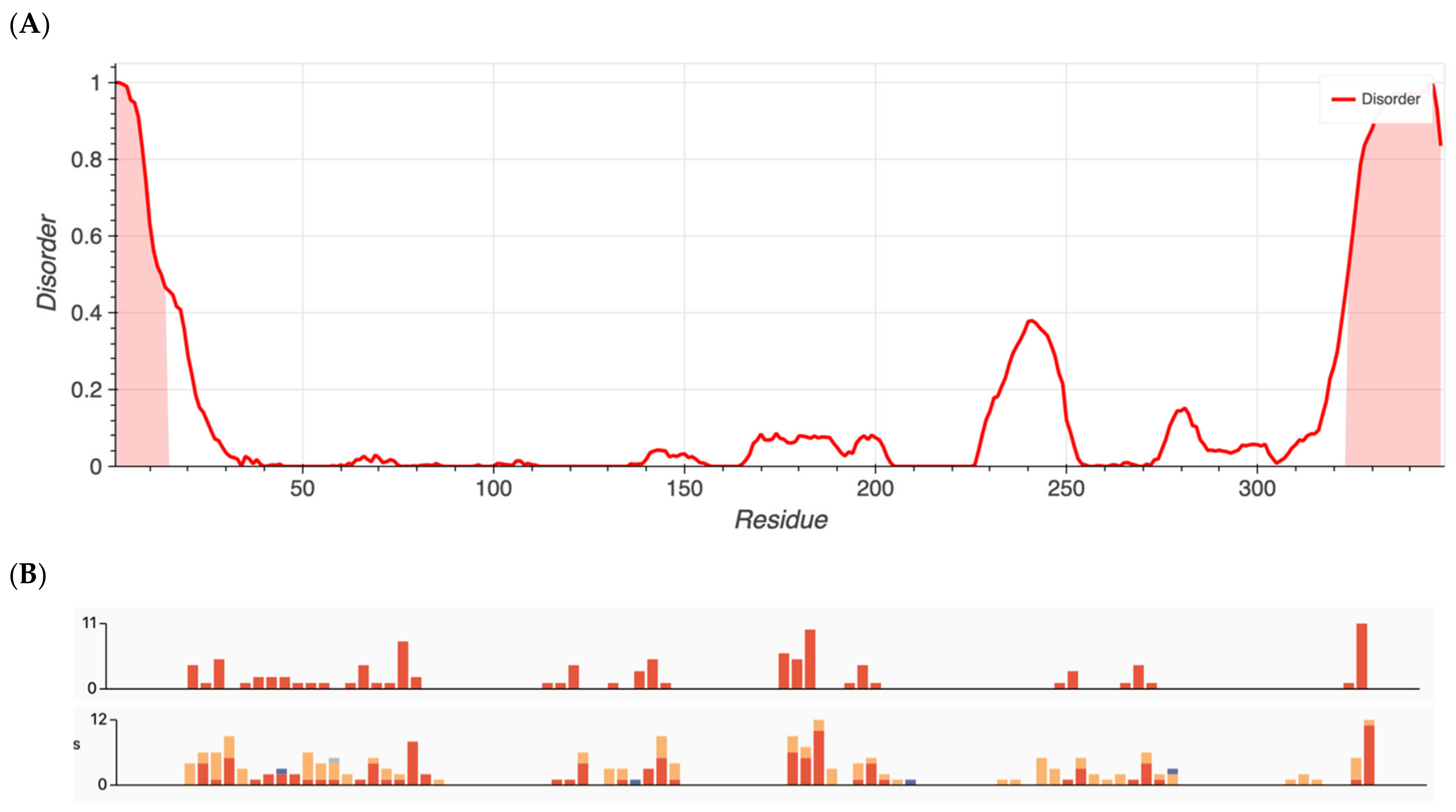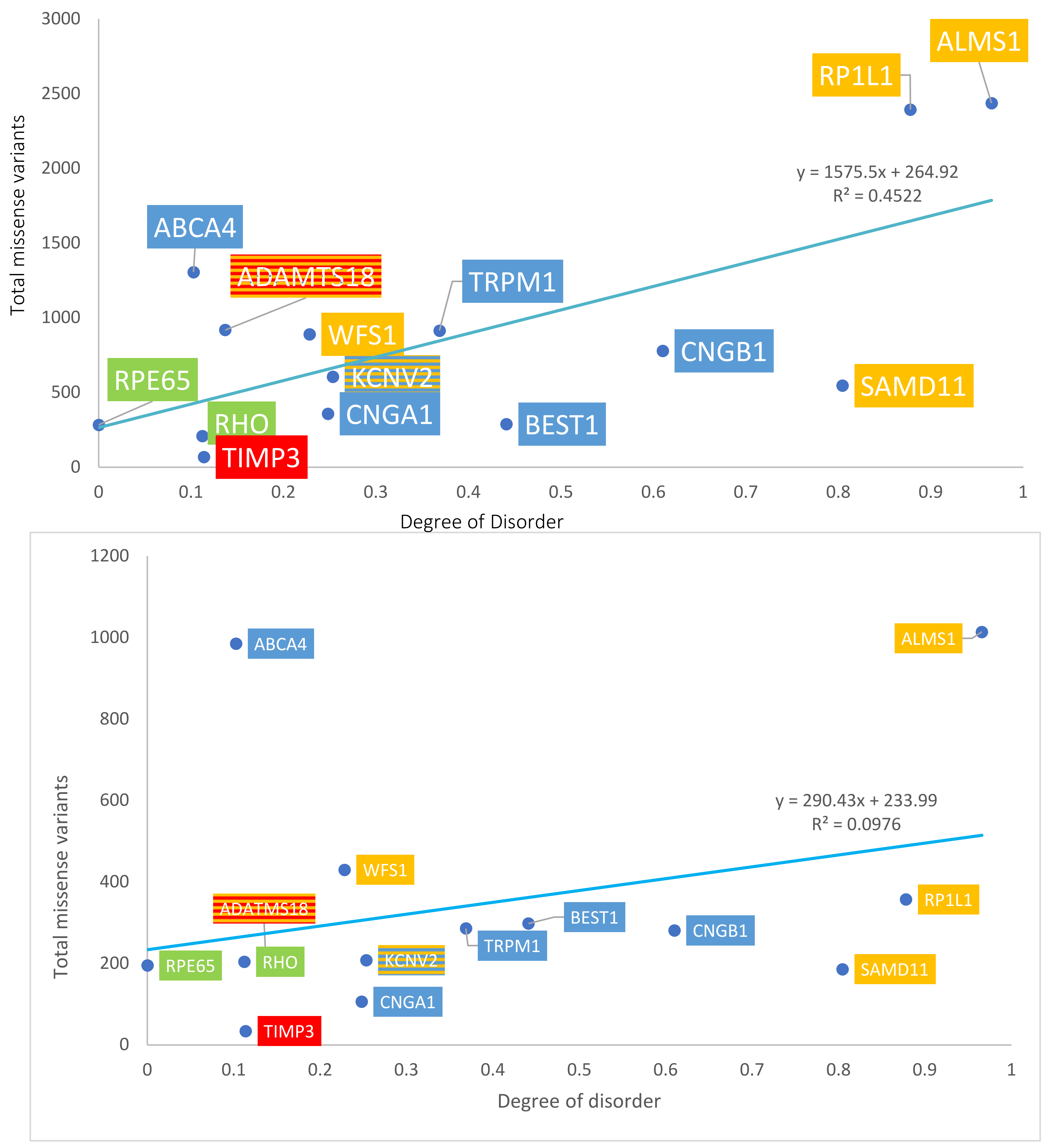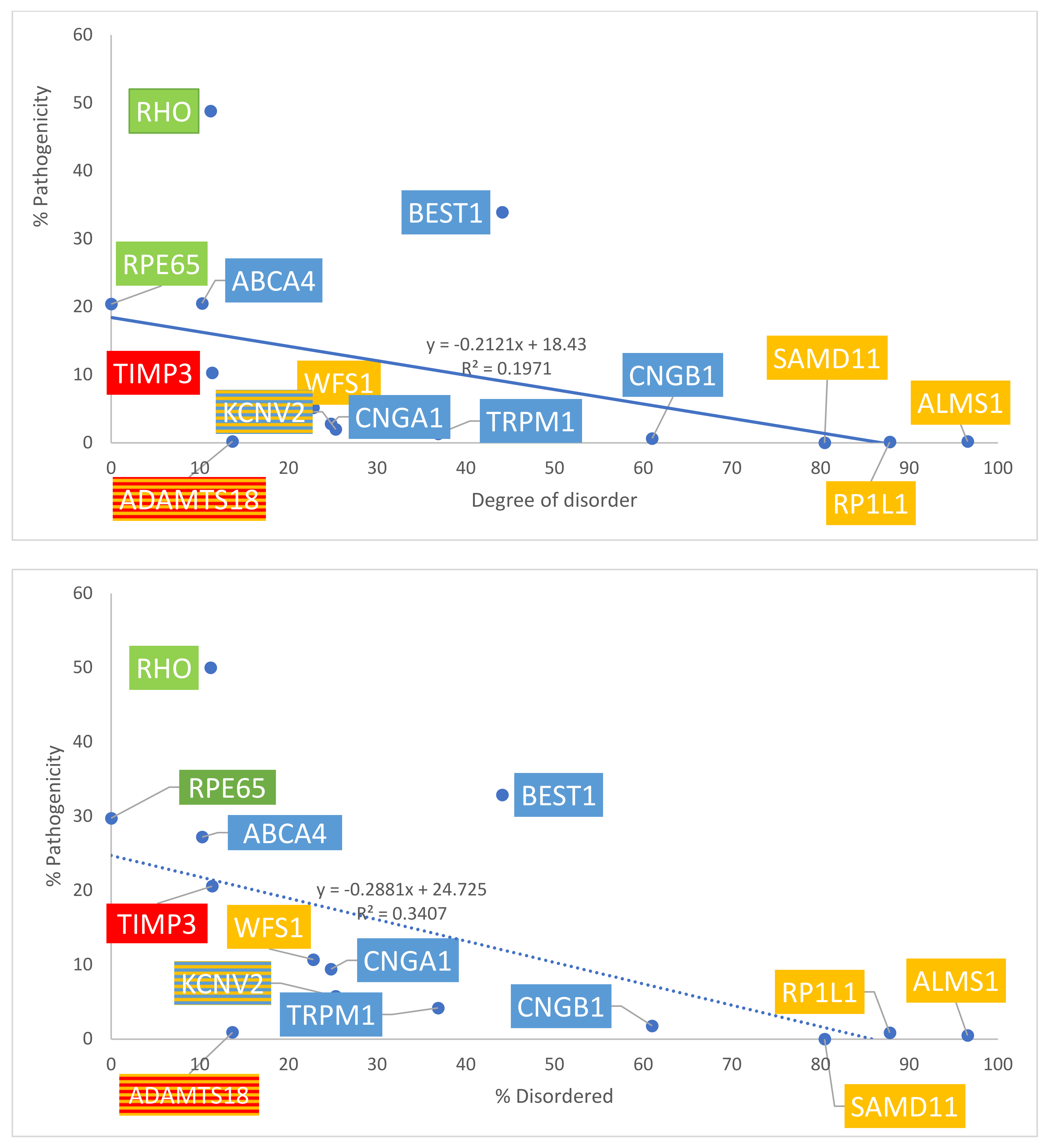Initial Investigations of Intrinsically Disordered Regions in Inherited Retinal Diseases
Abstract
:1. Introduction
2. Results
2.1. Analysis of Degree of Disorder
2.2. Proteins with Higher Disordered Regions Tolerate a Higher Amount of Total Missense Variation
3. Discussion
4. Materials and Methods
4.1. Prediction of Intrinsically Disordered Regions
4.2. Variant Pathogenicity
4.3. Statistical Analysis
5. Conclusions
Supplementary Materials
Author Contributions
Funding
Institutional Review Board Statement
Informed Consent Statement
Data Availability Statement
Conflicts of Interest
References
- Van Der Lee, R.; Buljan, M.; Lang, B.; Weatheritt, R.J.; Daughdrill, G.W.; Dunker, A.K.; Fuxreiter, M.; Gough, J.; Gsponer, J.; Jones, D.T.; et al. Classification of Intrinsically Disordered Regions and Proteins. Chem. Rev. 2014, 114, 6589–6631. [Google Scholar] [CrossRef] [PubMed]
- Willekens, K.; Rocha, R.; Van Keer, K.; Vandewalle, E.; Pinto, L.A.; Stalmans, I.; Marques-Neves, C. Review on Dynamic Contour Tonometry and Ocular Pulse Amplitude. Ophthalmic Res. 2015, 55, 91–98. [Google Scholar] [CrossRef] [PubMed]
- McFadden, W.M.; Yanowitz, J.L. idpr: A package for profiling and analyzing Intrinsically Disordered Proteins in R. PLoS ONE 2022, 17, e0266929. [Google Scholar] [CrossRef] [PubMed]
- Theillet, F.-X.; Kalmar, L.; Tompa, P.; Han, K.-H.; Selenko, P.; Dunker, A.K.; Daughdrill, G.W.; Uversky, V.N. The alphabet of intrinsic disorder. Intrinsically Disord. Proteins 2013, 1, e24360. [Google Scholar] [CrossRef] [PubMed] [Green Version]
- Kodera, N.; Noshiro, D.; Dora, S.K.; Mori, T.; Habchi, J.; Blocquel, D.; Gruet, A.; Dosnon, M.; Salladini, E.; Bignon, C.; et al. Structural and dynamics analysis of intrinsically disordered proteins by high-speed atomic force microscopy. Nat. Nanotechnol. 2020, 16, 181–189. [Google Scholar] [CrossRef]
- Berlow, R.; Dyson, H.J.; Wright, P.E. Functional advantages of dynamic protein disorder. FEBS Lett. 2015, 589, 2433–2440. [Google Scholar] [CrossRef] [Green Version]
- Van der Lee, R.; Lang, B.; Kruse, K.; Gsponer, J.; de Groot, N.S.; Huynen, M.A.; Matouschek, A.; Fuxreiter, M.; Babu, M.M. Intrinsically Disordered Segments Affect Protein Half-Life in the Cell and during Evolution. Cell Rep. 2014, 8, 1832–1844. [Google Scholar] [CrossRef] [Green Version]
- Trivedi, R.; Nagarajaram, H.A. Intrinsically Disordered Proteins: An Overview. Int. J. Mol. Sci. 2022, 23, 14050. [Google Scholar] [CrossRef]
- Wright, P.E.; Dyson, H.J. Intrinsically unstructured proteins: Re-assessing the protein structure-function paradigm. J. Mol. Biol. 1999, 293, 321–331. [Google Scholar] [CrossRef] [Green Version]
- Fujiwara, S. Dynamical Behavior of Disordered Regions in Disease-Related Proteins Revealed by Quasielastic Neutron Scattering. Medicina 2022, 58, 795. [Google Scholar] [CrossRef]
- Monti, S.M.; De Simone, G.; Langella, E. The Amazing World of IDPs in Human Diseases II. Biomolecules 2022, 12, 369. [Google Scholar] [CrossRef]
- Coskuner-Weber, O.; Mirzanli, O.; Uversky, V.N. Intrinsically disordered proteins and proteins with intrinsically disordered regions in neurodegenerative diseases. Biophys. Rev. 2022, 14, 679–707. [Google Scholar] [CrossRef]
- Schneider, N.; Sundaresan, Y.; Gopalakrishnan, P.; Beryozkin, A.; Hanany, M.; Levanon, E.Y.; Banin, E.; Ben-Aroya, S.; Sharon, D. Inherited retinal diseases: Linking genes, disease-causing variants, and relevant therapeutic modalities. Prog. Retin. Eye Res. 2021, 89, 101029. [Google Scholar] [CrossRef]
- Tanner, A.; Chan, H.W.; Schiff, E.; Mahroo, O.M.; Pulido, J.S. Exploring the mutational landscape of genes associated with inherited retinal disease using large genomic datasets: Identifying loss of function intolerance and outlying propensities for missense changes. BMJ Open Ophthalmol. 2022, 7, e001079. [Google Scholar] [CrossRef]
- Bürgi, J.; Xue, B.; Uversky, V.N.; van der Goot, F.G. Intrinsic Disorder in Transmembrane Proteins: Roles in Signaling and Topology Prediction. PLoS ONE 2016, 11, e0158594. [Google Scholar] [CrossRef] [Green Version]
- Mohammad, I.-L.; Mateos, B.; Pons, M. The disordered boundary of the cell: Emerging properties of membrane-bound intrinsically disordered proteins. Biomol. Concepts 2019, 10, 25–36. [Google Scholar] [CrossRef]
- Wang, X.; Wei, X.; Thijssen, B.; Das, J.; Lipkin, S.M.; Yu, H. Three-dimensional reconstruction of protein networks provides insight into human genetic disease. Nat. Biotechnol. 2012, 30, 159–164. [Google Scholar] [CrossRef] [Green Version]
- Vacic, V.; Markwick, P.R.L.; Oldfield, C.J.; Zhao, X.; Haynes, C.; Uversky, V.N.; Iakoucheva, L.M. Disease-Associated Mutations Disrupt Functionally Important Regions of Intrinsic Protein Disorder. PLoS Comput. Biol. 2012, 8, e1002709. [Google Scholar] [CrossRef]
- Laddach, A.; Ng, J.C.F.; Fraternali, F. Pathogenic missense protein variants affect different functional pathways and proteomic features than healthy population variants. PLoS Biol. 2021, 19, e3001207. [Google Scholar] [CrossRef]
- Emenecker, R.J.; Griffith, D.; Holehouse, A.S. Metapredict V2: An update to metapredict, a fast, accurate, and easy-to-use predictor of consensus disorder and structure. bioRxiv 2022. [Google Scholar] [CrossRef]
- Emenecker, R.J.; Griffith, D.; Holehouse, A.S. Metapredict: A fast, accurate, and easy-to-use predictor of consensus disorder and structure. Biophys. J. 2021, 120, 4312–4319. [Google Scholar] [CrossRef] [PubMed]
- Uppal, S.; Liu, T.; Galvan, E.; Gomez, F.; Tittley, T.; Poliakov, E.; Gentleman, S.; Redmond, T.M. An inducible amphipathic α-helix mediates subcellular targeting and membrane binding of RPE65. Life Sci. Alliance 2022, 6, e202201546. [Google Scholar] [CrossRef] [PubMed]
- Ganne, A.; Balasubramaniam, M.; Ayyadevara, S.; Reis, R.J.S. Machine-learning analysis of intrinsically disordered proteins identifies key factors that contribute to neurodegeneration-related aggregation. Front. Aging Neurosci. 2022, 14, 938117. [Google Scholar] [CrossRef] [PubMed]
- Gupta, A.; Dey, S.; Hicks, A.; Zhou, H.-X. Artificial intelligence guided conformational mining of intrinsically disordered proteins. Commun. Biol. 2022, 5, 610. [Google Scholar] [CrossRef]
- Gudmundsson, S.; Singer-Berk, M.; Watts, N.A.; Phu, W.; Goodrich, J.K.; Solomonson, M.; Rehm, H.L.; MacArthur, D.G.; O’Donnell-Luria, A.; Genome Aggregation Database Consortium. Variant interpretation using population databases: Lessons from gnomAD. Hum. Mutat. 2021, 43, 1012–1030. [Google Scholar] [CrossRef]
- Landrum, M.J.; Lee, J.M.; Benson, M.; Brown, G.R.; Chao, C.; Chitipiralla, S.; Gu, B.; Hart, J.; Hoffman, D.; Jang, W.; et al. ClinVar: Improving access to variant interpretations and supporting evidence. Nucleic Acids Res. 2017, 46, D1062–D1067. [Google Scholar] [CrossRef]





| (A) | |||
|---|---|---|---|
| Protein Name | # Total Missense Variants (Clinvar) | # Total Missense Variants (gnomAD) | # Pathogenic Missense Variants |
| SAMD11 | 186 | 546 | 0 |
| ALMS1 | 1014 | 2437 | 5 |
| WFS1 | 430 | 890 | 46 |
| RP1L1 | 357 | 2394 | 3 |
| ADAMTS18 | 220 | 919 | 2 |
| CNGB1 | 281 | 779 | 5 |
| KCNV2 | 208 | 606 | 12 |
| CNGA1 | 106 | 358 | 10 |
| TRPM1 | 286 | 914 | 12 |
| ABCA4 | 985 | 1306 | 268 |
| BEST1 | 298 | 289 | 98 |
| RHO | 204 | 209 | 102 |
| RPE65 | 195 | 284 | 58 |
| TIMP3 | 34 | 68 | 7 |
| (B) | |||
| Protein Name | % Pathogenicity (Clinvar) | % Pathogenicity (gnomAD) | |
| SAMD11 | 0 | 0 | |
| ALMS1 | 0.493096647 | 0.205170291 | |
| WFS1 | 10.69767442 | 5.168539326 | |
| RP1L1 | 0.840336134 | 0.125313283 | |
| ADAMTS18 | 0.909090909 | 0.217627856 | |
| CNGB1 | 1.779359431 | 0.641848524 | |
| KCNV2 | 5.769230769 | 1.98019802 | |
| CNGA1 | 9.433962264 | 2.793296089 | |
| TRPM1 | 4.195804196 | 1.312910284 | |
| ABCA4 | 27.20812183 | 20.52067381 | |
| BEST1 | 32.88590604 | 33.9100346 | |
| RHO | 50 | 48.80382775 | |
| RPE65 | 29.74358974 | 20.42253521 | |
| TIMP3 | 20.58823529 | 10.29411765 | |
Disclaimer/Publisher’s Note: The statements, opinions and data contained in all publications are solely those of the individual author(s) and contributor(s) and not of MDPI and/or the editor(s). MDPI and/or the editor(s) disclaim responsibility for any injury to people or property resulting from any ideas, methods, instructions or products referred to in the content. |
© 2023 by the authors. Licensee MDPI, Basel, Switzerland. This article is an open access article distributed under the terms and conditions of the Creative Commons Attribution (CC BY) license (https://creativecommons.org/licenses/by/4.0/).
Share and Cite
Lee, K.E.; Procopio, R.; Pulido, J.S.; Gunton, K.B. Initial Investigations of Intrinsically Disordered Regions in Inherited Retinal Diseases. Int. J. Mol. Sci. 2023, 24, 1060. https://doi.org/10.3390/ijms24021060
Lee KE, Procopio R, Pulido JS, Gunton KB. Initial Investigations of Intrinsically Disordered Regions in Inherited Retinal Diseases. International Journal of Molecular Sciences. 2023; 24(2):1060. https://doi.org/10.3390/ijms24021060
Chicago/Turabian StyleLee, Karen E., Rebecca Procopio, Jose S. Pulido, and Kammi B. Gunton. 2023. "Initial Investigations of Intrinsically Disordered Regions in Inherited Retinal Diseases" International Journal of Molecular Sciences 24, no. 2: 1060. https://doi.org/10.3390/ijms24021060




